

Find Synonyms and Antonyms of Words at Thesaurus.com. Additional Research. Design Psychology - About Design Psychology. Bombarded by messages about how your place “should” or “must” look?
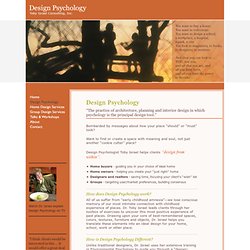
Want to find or create a space with meaning and soul, not just another “cookie cutter” place? Psychology for Designers. Homes: The Psychology Of Colour. Colour Psychology In Design. Colour Emotion Guide. Virtual reality. U.S.

Navy personnel using a mock VR parachute trainer. Virtual Reality (VR), which can be referred to as immersive multimedia or computer-simulated life, replicates an environment that simulates physical presence in places in the real world or imagined worlds. Virtual reality can recreate sensory experiences, which include virtual taste, sight, smell, sound, and touch. Most up to date virtual reality environments are displayed either on a computer screen or with special stereoscopic displays, and some simulations include additional sensory information and emphasise real sound through speakers or headphones targeted towards VR users. Some advanced, haptic, systems now include tactile information, generally known as force feedback in medical, gaming and military applications.
Concept origins[edit] History of Virtual Reality - where did it all begin? The History of Virtual Reality – otherwise known as VR.
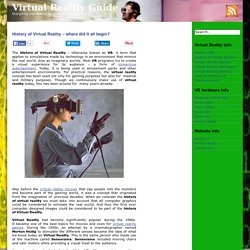
A term that applies to simulations made by technology in an environment that mimics the real world. Also as imaginary worlds. Most VR programs try to create a visual experience for its audience – a form of immersive entertainment. Today, it is being used in amusement parks and other entertainment environments. For practical reasons, the virtual reality concept has been used not only for gaming purposes but also for medical and military purposes. VIRTUAL REALITY - History. Expo/Theater/Virtual Environments | Forward | Back | Map | Information | Expo Home | Beginnings Virtual reality may have popped into the headlines only in the past few years, but its roots reach back four decades.
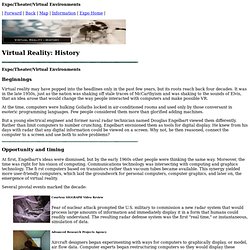
It was in the late 1950s, just as the nation was shaking off stale traces of McCarthyism and was shaking to the sounds of Elvis, that an idea arose that would change the way people interacted with computers and make possible VR. At the time, computers were hulking Goliaths locked in air-conditioned rooms and used only by those conversant in esoteric programming languages. Google - History of Virtual Reality. Mural. A mural is any piece of artwork painted or applied directly on a wall, ceiling or other large permanent surface.
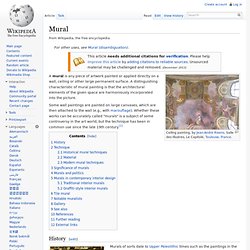
A distinguishing characteristic of mural painting is that the architectural elements of the given space are harmoniously incorporated into the picture. Some wall paintings are painted on large canvases, which are then attached to the wall (e.g., with marouflage). Whether these works can be accurately called "murals" is a subject of some controversy in the art world, but the technique has been in common use since the late 19th century.[1] History[edit] The History of Wall Murals. Kalkmalerier-Church Murals in Danish Churches- 360 Panorama - panorama foto. The Danish and Swedish church paintings are a unique concentration of church frescoes and murals in the world.

More than 600 churches have murals dated back to the Middle Ages. In most of Europe mediveal frescoes were destroid during the reformation but in Denmark most of them were covered by limewash and discovered again in the 1860s up until today. You can still discover hidden paintings under the many layers of limewash. There are 2 types of murals, the old Romanesque style made by artists coming from the rest of Europe dating back to the 12th century, and the Gothic style made from the middle of 13th century to 15th century. The paintings from the 13-15th century are made by local Danish artists who developed there own style.
Marvellous Murals. Neil-wilkinson-mural. 360 murals. Virtual environment software. Virtual environment software refers to any software, program or system that implements, manages and controls multiple virtual environment instances.
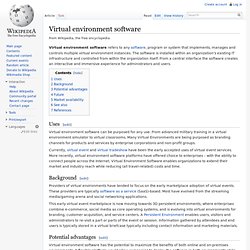
The software is installed within an organization's existing IT infrastructure and controlled from within the organization itself. From a central interface the software creates an interactive and immersive experience for administrators and users. Uses[edit] Virtual environment software can be purposed for any use. Virtual environment. This article or section is incomplete and its contents need further attention.
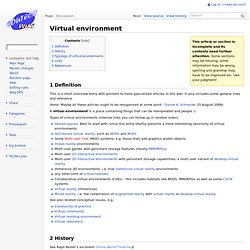
Some sections may be missing, some information may be wrong, spelling and grammar may have to be improved etc. Use your judgment! 1 Definition This is a short overview entry with pointers to more specialized articles in this wiki. It also includes some general links and reference. (Note: Maybe all these articles ought to be reorganized at some point - Daniel K. Virtual Reality and Education Virtual Reality. Education is another area which has adopted virtual reality for teaching and learning situations.
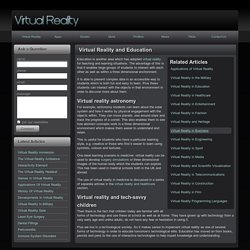
The advantage of this is that it enables large groups of students to interact with each other as well as within a three dimensional environment. It is able to present complex data in an accessible way to students which is both fun and easy to learn. Plus these students can interact with the objects in that environment in order to discover more about them. Virtual reality in medicine. Virtual reality is used in both the medical and dentistry fields where it has several advantages over conventional systems.
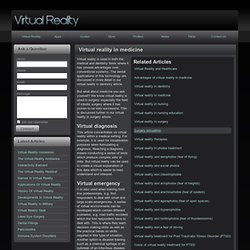
The dental applications of this technology are discussed in more detail in our virtual reality in dentistry article. But what about medicine you ask yourself? We know virtual reality is used in surgery, especially the field of robotic surgery where it has proven to be very successful. The Virtual Reality Medical Center. Virtual reality medicine. Virtual reality medicine. Virtual reality education. Article: Educational Uses of VR Technology. GCSE Bitesize: Virtual reality. Interior design psychology. Interior design psychology is a field within environmental psychology, which concerns the environmental conditions of the interior. It is a direct study of the relationship between an environment and how that environment affects the behaviour of its inhabitants, with the aim of maximising the positive affects of this relationship.
Through interior design psychology the performance and efficiency of the space and the wellbeing of the individual are improved. Figures like Walter Benjamin, Sigmund Freud, John B. Proxemics. Proxemics is a subcategory of the study of nonverbal communication along with haptics (touch), kinesics (body movement), vocalics (paralanguage), and chronemics (structure of time).[1] Proxemics can be defined as "the interrelated observations and theories of man's use of space as a specialized elaboration of culture".[2] Edward T.
Hall, the cultural anthropologist who coined the term in 1963, emphasized the impact of proxemic behavior (the use of space) on interpersonal communication. Hall believed that the value in studying proxemics comes from its applicability in evaluating not only the way people interact with others in daily life, but also "the organization of space in [their] houses and buildings, and ultimately the layout of [their] towns.[3] Personal space[edit] The most portable types of space. A person's personal space is carried with them everywhere they go. Kinesthetic factors. The psychology of design explained - Features. Anna Richardson Taylor explores the importance of an understanding of psychology when it comes to design What does the World Wide Fund for Nature’s logo have in common with a jar of Waitrose Honey?
They both use a stylised image of an animal, and are examples of simple yet effective design. They are also both neat practical applications of the psychological theories of Gestalt. Developed by German psychologists in the 1920s, Gestalt theories explain how people tend to organise visual elements into groups, and how the whole is often greater than its parts. Their application takes advantage of how the brain self-organises information in a manner that’s orderly, regular, symmetrical and simple. Purport: Definition. Decoding colour: Use colour psychology to create better designs - Features. Designers are used to thinking about colours being warm or cold, clashing or complementary, based on their touches of blue or red, or their position on the colour wheel. For Angela Wright, colour psychologist and founder of consultancy Colour Affects (www.colour-affects.co.uk) there’s more to it than that. Wright has gone beyond what looks nice to discover why particular wavelengths stimulate the brain.
Citadel Wallpaper: Virtual Reality House. Augmented Reality Immersive Environments: Experience Catcher. The Luminarium. CAVE Virtual Reality: Sun Microsystems & Fakespace Systems. Paradise Environment Concept. Jacqui Taylor's Thesis Research Survey (1): Phobias. Thank you for taking the time to complete this survey and assist me with my thesis research. This survey should only take about 10-20 minutes of your time to complete.
All questions marked with asterisks (*) require an answer in order to progress through the survey. Responses gathered from this survey will be treated with participant confidentiality and anonymity.You will be asked to provide an email address at the end of the survey, though it is optional to provide this information. Your email address will only be used to contact you about your participation in this survey, and potential participation in future related research. Results collected will be directly accessible only by the researcher (myself), and once submitted, you will be unable to edit your responses. You may withdraw your participation from the research study at any time. Regards, Jacqui Taylor.
Virtual Environments in Clinical Psychology and Neuroscience - A book about the applications of virtual reality in medicine, neurology and psychology. Scientific discovery is a form of problem solving, and… the processes whereby science is carried on can be explained in the terms that have been used to explain the processes of problem solving. Simon, 1966.